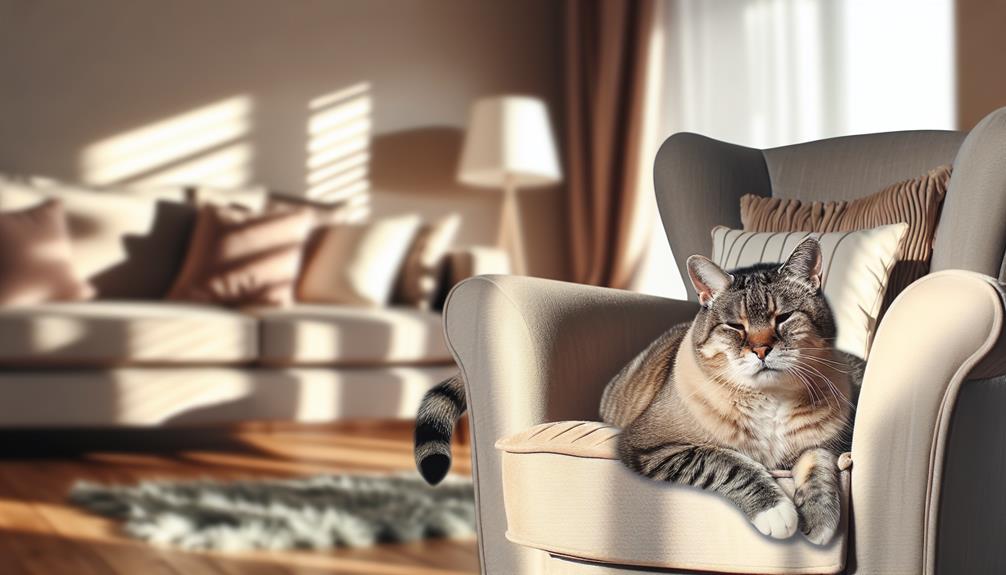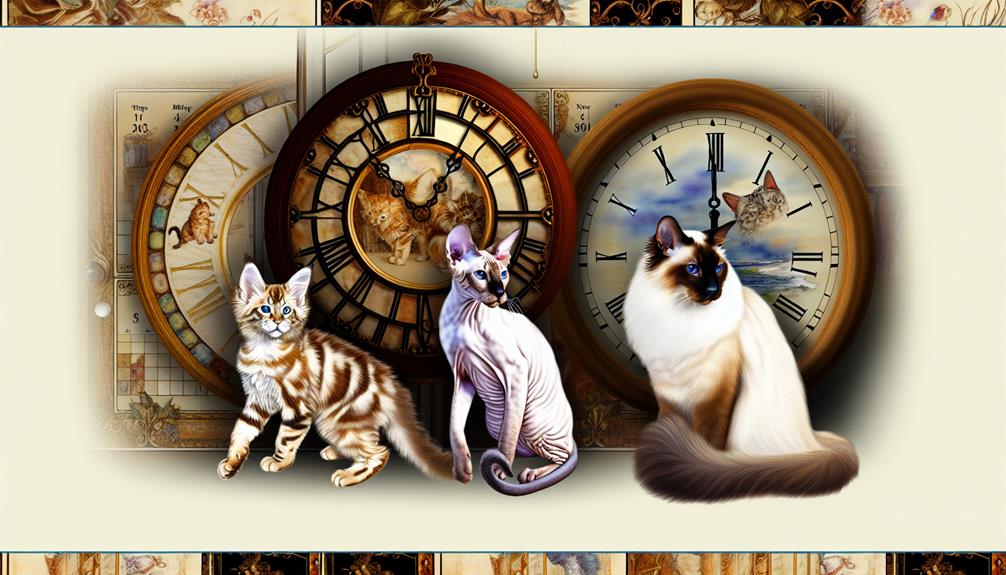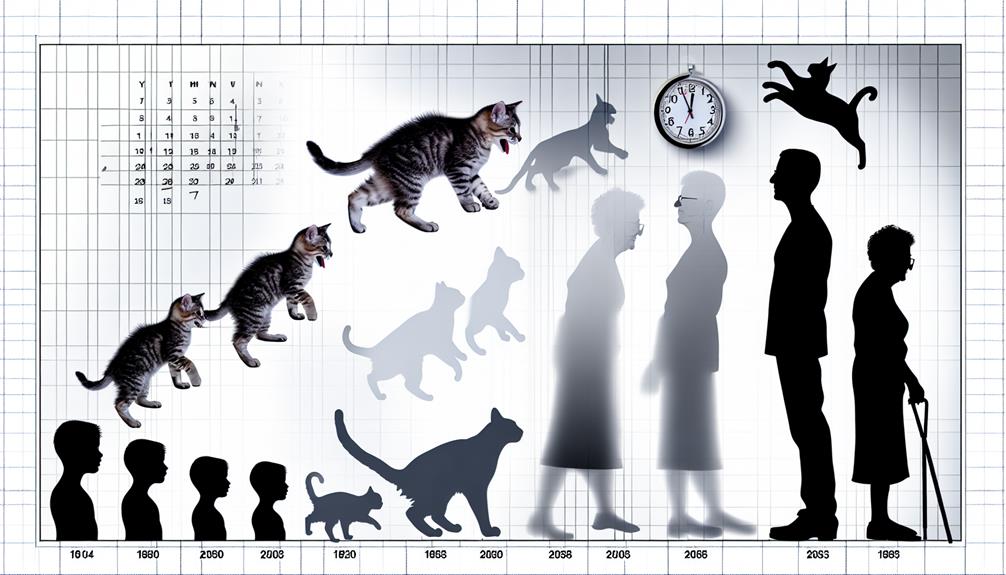When your kitten reaches its first birthday, it's like they've already turned 15 in human years. You might be surprised by how quickly cats mature compared to humans. The rapid development in the first two years can make a two-year-old feline seem almost 24 in human terms. But what happens beyond those initial years? As your cat evolves from youth to middle age, the aging process slows, adding about 4 cat years for each human year. Understanding this can greatly impact how you care for them, especially as they move into their senior years. So, how should this knowledge shape your approach to feline care?
Understanding Feline Aging
Understanding feline aging is vital for effectively managing your cat's health and well-being. As cats age, they undergo significant physiological and behavioral changes that reflect their stage of development. Feline development is divided into several life stages: kittenhood, junior, prime, mature, senior, and geriatric. Each stage brings about specific health considerations and alterations in behavior.
In the early stages of life, rapid growth and development are paramount. As your cat shifts from kittenhood to adulthood, you'll notice changes in activity levels, dietary needs, and social behavior. Behavioral changes such as increased independence, alterations in play behaviors, and shifts in social hierarchy within multi-cat households are common. Understanding these changes can help you provide appropriate environmental enrichment and nutritional support.
As cats enter their mature years, typically around seven years of age, you'll observe more pronounced behavioral changes. Cats might become less active, exhibit changes in sleeping patterns, and show signs of cognitive aging. It's essential to monitor for early signs of health issues like arthritis, dental disease, and kidney problems, which are prevalent in aging felines. Regular veterinary check-ups become increasingly important to detect and manage age-related conditions.
The First Two Years
Although the first two years of a cat's life encompass rapid developmental milestones, these initial stages are essential for establishing a foundation for lifelong health and behavior. During this period, kitten development progresses at an accelerated rate, equating to substantial physiological and behavioral changes. By the end of the first year, a cat is roughly equivalent to a 15-year-old human regarding growth and maturity.
In the first several weeks, kittens experience significant early milestones such as opening their eyes, developing coordination, and beginning exploratory behaviors. By the age of three weeks, the socialization window opens, making interactions with humans and other animals vital for behavioral development. Failure to properly socialize during this period can lead to lifelong behavioral issues.
Between the age of two to six months, kittens undergo rapid growth spurts and develop fine motor skills. This stage is equivalent to a human toddler's development phase. Nutritional needs are paramount; a high-protein diet supports muscle and skeletal development. Additionally, cognitive abilities expand as kittens learn to hunt, play, and interact with their environment, which is essential for mental stimulation and future problem-solving skills.
From six months to two years, sexual maturity is reached, marking the shift from adolescence to young adulthood. By the end of the second year, cats are approximately 24 human years old. Spaying or neutering during this period can prevent unwanted behaviors and health issues related to reproduction. Understanding these stages of kitten development underscores the importance of appropriate care, nutrition, and socialization in these formative years to guarantee a well-adjusted adult cat.
Middle-Aged Cats

As cats undergo a shift into middle age, typically around seven to ten years old, their physiological and behavioral changes become more evident. You'll notice alterations in cat behavior, such as reduced activity levels and more sedentary habits. These changes require a tailored approach to middle-aged care, focusing on a balanced feline diet that meets their evolving nutritional requirements.
Monitoring health is crucial during this stage. Regular veterinary visits should be scheduled to detect early signs of age-related conditions such as arthritis, dental disease, and metabolic disorders. Health monitoring can include routine blood tests, dental check-ups, and weight assessments to guarantee your cat remains in peak health.
Personality changes might also occur, with some cats becoming more aloof or conversely, more affectionate. It's vital to observe these shifts and adjust your interactions accordingly. Social interactions should be maintained, as companionship and mental stimulation play critical roles in a cat's well-being.
Environmental enrichment becomes increasingly significant for middle-aged cats. Providing stimulating toys, scratching posts, and interactive playtime can help mitigate the decline in activity levels. Grooming needs may also increase due to a potential decrease in self-grooming behavior. Regular brushing will help maintain their coat's health and reduce the risk of matting and hairballs.
Guaranteeing your cat's diet is appropriate for their age can help manage weight and prevent obesity, a common issue in middle-aged felines. Specialized diets often contain joint supplements and lower calorie content to support overall health.
Senior Cat Years
When your cat reaches senior years, typically around 11-14 years, you'll notice significant changes in their aging process, with decreased mobility and altered behavior. Senior cat health demands increased attention to common geriatric conditions such as arthritis, kidney disease, and dental issues, requiring regular veterinary check-ups. Understanding the lifespan and care needs of senior cats is essential for providing appropriate nutrition, environment, and medical interventions to enhance their quality of life.
Aging Process in Cats
In the later stages of a cat's life, typically starting around the age of 10 to 12 years, cats enter what is known as their senior years. During this phase, feline development undergoes significant changes. You'll notice alterations in cat behavior, as senior cats often become less active and may exhibit increased periods of rest. These behavioral modifications are a natural consequence of aging and are driven by physiological transformations within their bodies.
From a scientific perspective, the aging process in cats involves a gradual decline in cellular function and metabolic rate. This decline contributes to the observable changes in their daily activities. The reduction in activity levels can also be attributed to age-related joint stiffness or discomfort, impacting their overall mobility.
Furthermore, cognitive functions in senior cats may exhibit a decline, akin to the aging process in humans. This phenomenon, often referred to as feline cognitive dysfunction, can lead to altered sleep-wake cycles and changes in interactions with their environment. It's vital to monitor these aspects of feline development closely.
Understanding these behavioral and physiological changes is essential for providing the necessary care and adjustments to your senior cat's routine, ensuring they enjoy a comfortable and fulfilling life during their later years.
Senior Cat Health
Caring for senior cats requires an understanding of the specific health challenges they face as they age. As felines reach their geriatric years, typically around the age of 10, they are prone to various conditions such as arthritis, renal insufficiency, and hyperthyroidism. Effective geriatric care involves regular veterinary check-ups, as early detection of issues can greatly improve their quality of life.
Senior nutrition plays a critical role in maintaining the health of aging cats. Diets formulated for senior felines often contain reduced calorie levels to account for decreased activity, while providing increased fiber to support gastrointestinal health. Additionally, these diets may include supplements like omega-3 fatty acids which can help manage arthritis and promote healthy skin and coat.
It's vital to monitor your senior cat's body condition closely. Weight loss or gain can be indicative of underlying health problems. Regular blood work and urinalysis are recommended to monitor renal function and detect potential metabolic disorders early. By focusing on senior nutrition and thorough geriatric care, you can help guarantee that your aging feline enjoys a comfortable and healthy senior phase. Always consult your veterinarian to tailor a care plan specific to your cat's needs.
Lifespan and Care
As cats shift into their senior years, their lifespan and care requirements become increasingly nuanced. Unlike kitten care, senior cats require specialized attention to their nutrition needs, exercise requirements, and grooming habits. It's critical to monitor for behavioral changes, which can indicate underlying health issues. Environmental enrichment and stress management become focal points to guarantee a high quality of life.
| Aspect | Senior Cats | Kitten Care |
|---|---|---|
| Nutrition Needs | High protein, low phosphorous | High calorie, frequent meals |
| Exercise Requirements | Gentle play, short sessions | Vigorous play, longer sessions |
| Grooming Habits | Regular brushing, dental care | Basic grooming, nail trims |
| Behavioral Changes | Monitor closely for signs | Typical growth, playful |
| Environmental Enrichment | Senior-friendly toys, quiet spaces | Interactive toys, socialization |
Behavioral changes in senior cats might include increased vocalization, altered sleep patterns, or decreased appetite. Employ training techniques and bonding activities tailored to their decreased mobility. Socialization tips for older cats emphasize gentle interactions and maintaining familiar routines to reduce stress.
Incorporate these adjustments into your cat's daily routine to address their evolving needs. Employing evidence-based strategies will not only prolong their lifespan but also enhance their overall well-being. Remember, the goal is to create a nurturing environment that supports both their physical and emotional health.
Breed and Lifespan

When considering a cat's lifespan, the breed plays a notable role in determining longevity. Various breed characteristics, such as genetic predispositions, size, and metabolic rates, directly contribute to lifespan variation among feline breeds. For instance, the Siamese breed is noted for its extended lifespan, often living 15 to 20 years, whereas larger breeds like the Maine Coon typically have a shorter lifespan of around 10 to 13 years.
Genetic factors inherent to specific breeds can influence vulnerability to certain diseases and conditions, thereby affecting overall lifespan. For example, Persian cats are prone to polycystic kidney disease (PKD), which can greatly reduce their lifespan if not managed properly. On the other hand, breeds like the Russian Blue are known for their robust health and minimal genetic health issues, contributing to their longer average lifespan.
In addition to genetic predispositions, physiological traits linked to breed characteristics also play a role. Smaller breeds, like the Singapura, tend to have higher metabolic rates but are less susceptible to obesity-related conditions, consequently often enjoying longer lifespans. Conversely, larger breeds may experience more joint and heart issues, impacting their longevity.
Furthermore, breed-specific behavioral tendencies can influence lifespan. Active breeds that engage in frequent physical activity, such as the Abyssinian, often benefit from better physical health and mental stimulation, potentially leading to a longer life. In contrast, more sedentary breeds may face challenges related to inactivity, such as obesity and diabetes, which can shorten their lifespan.
Understanding the breed-specific factors that influence lifespan can help you make informed decisions about care, ultimately ensuring a healthier, longer life for your feline companion.
Health Factors
While breed characteristics substantially impact a cat's lifespan, health factors play an equally vital role in determining longevity. A cat's dietary needs must be meticulously managed to guarantee balanced nutrition, which is foundational for overall health. High-quality protein sources, essential fatty acids, and micronutrients are fundamental for maintaining ideal physiological functions.
Preventive care, including routine veterinary check-ups, allows for early detection of potential health issues. Regular assessments of a cat's dental health can prevent periodontal disease, which has been linked to systemic conditions such as kidney and heart disease. A strict vaccination schedule is essential in safeguarding against infectious diseases, thereby extending a cat's life expectancy.
Environmental factors notably influence a cat's health. Indoor cats generally live longer due to reduced exposure to hazards such as traffic, predators, and infectious agents. However, indoor environments necessitate adequate mental stimulation and exercise habits to prevent obesity and boredom-related behavioral issues. Interactive toys and scheduled playtime can enhance cognitive function and keep a cat physically active.
Grooming routines are necessary for maintaining skin and coat health, as well as for early detection of abnormalities such as lumps or parasites. Regular grooming also prevents matting and hairballs, which can cause gastrointestinal complications.
Calculating Cat Years

Determining a cat's age in human terms involves more than a simple one-to-one ratio. The process of cat year conversion is rooted in understanding feline life stages, each marked by distinct physiological and behavioral changes. Initially, cats age rapidly in their first two years. For instance, a one-year-old cat is roughly equivalent to a 15-year-old human adolescent, experiencing rapid growth and development. By the second year, a cat reaches the equivalent of a 24-year-old human.
To simplify the conversion process, consider the following milestones:
- First year: Approximately 15 human years.
- Second year: Adds about 9 more human years, totaling 24 human years.
- Each subsequent year: Equates to around 4 human years.
- Mature cat (7-10 years): Comparable to a human in their mid-40s to mid-50s.
- Senior cat (11+ years): Analogous to a human in their 60s and beyond.
These conversions are based on scientific evidence indicating that cats mature faster in their early years and then age more slowly as they mature. Understanding these feline life stages can help you manage your cat's health more effectively.
For instance, knowing that a 10-year-old cat is roughly equivalent to a 56-year-old human can prompt more vigilant health screenings and dietary adjustments. This knowledge isn't just academic; it has practical implications for veterinary care, nutrition, and general well-being. By appreciating the nuances of cat year conversion, you can provide more tailored and effective care throughout your cat's life stages.
Conclusion
In understanding your cat's aging, it's essential to recognize their rapid early development and gradual aging thereafter. Just like a well-oiled machine, a cat's lifecycle gears shift markedly after the first two years. By considering breed, health, and other factors, you can better cater to your pet's needs. Remember, each year isn't just a number; it's a leap in their biological clock. Use this knowledge to guarantee your feline companion's well-being throughout their life.
